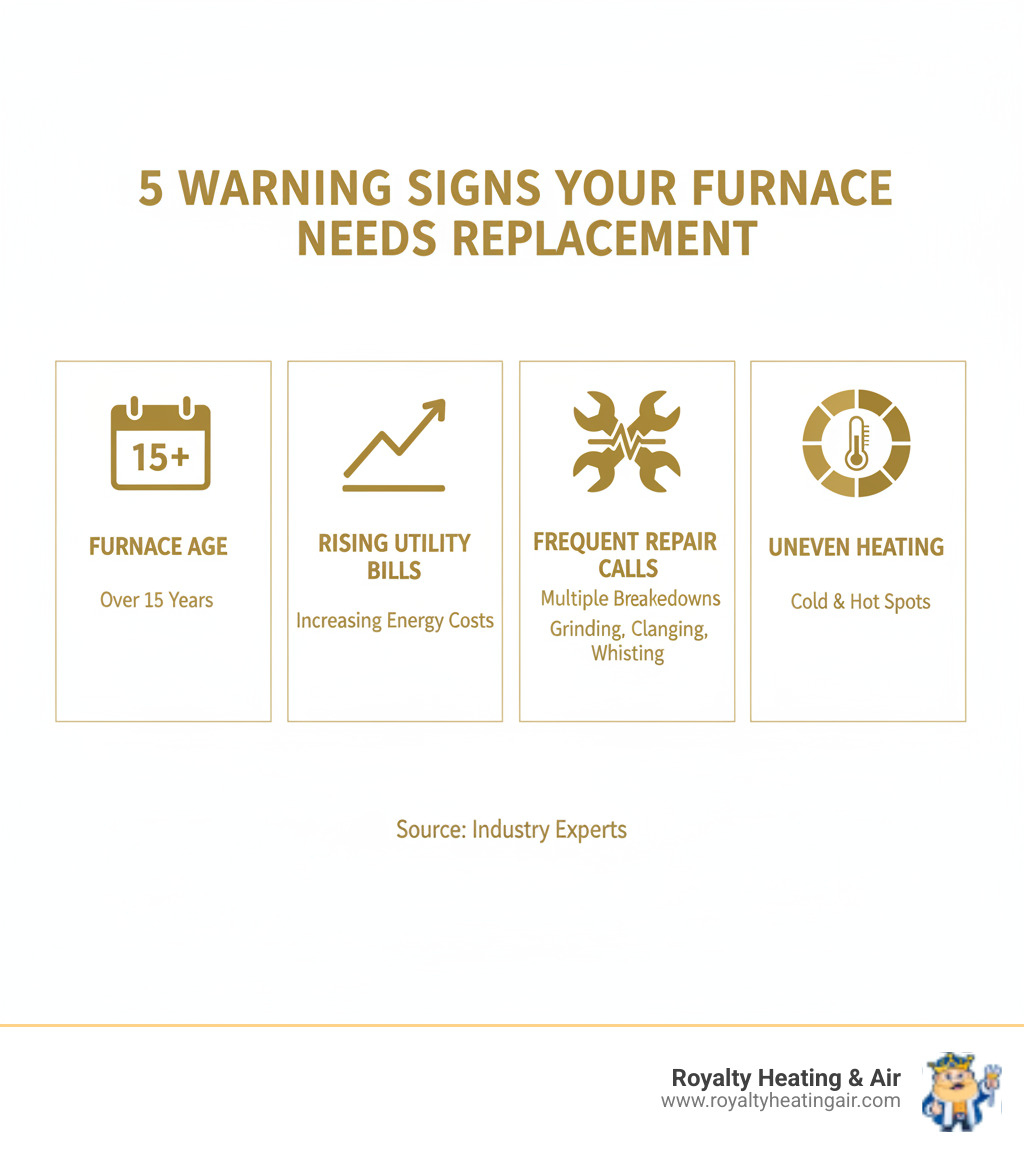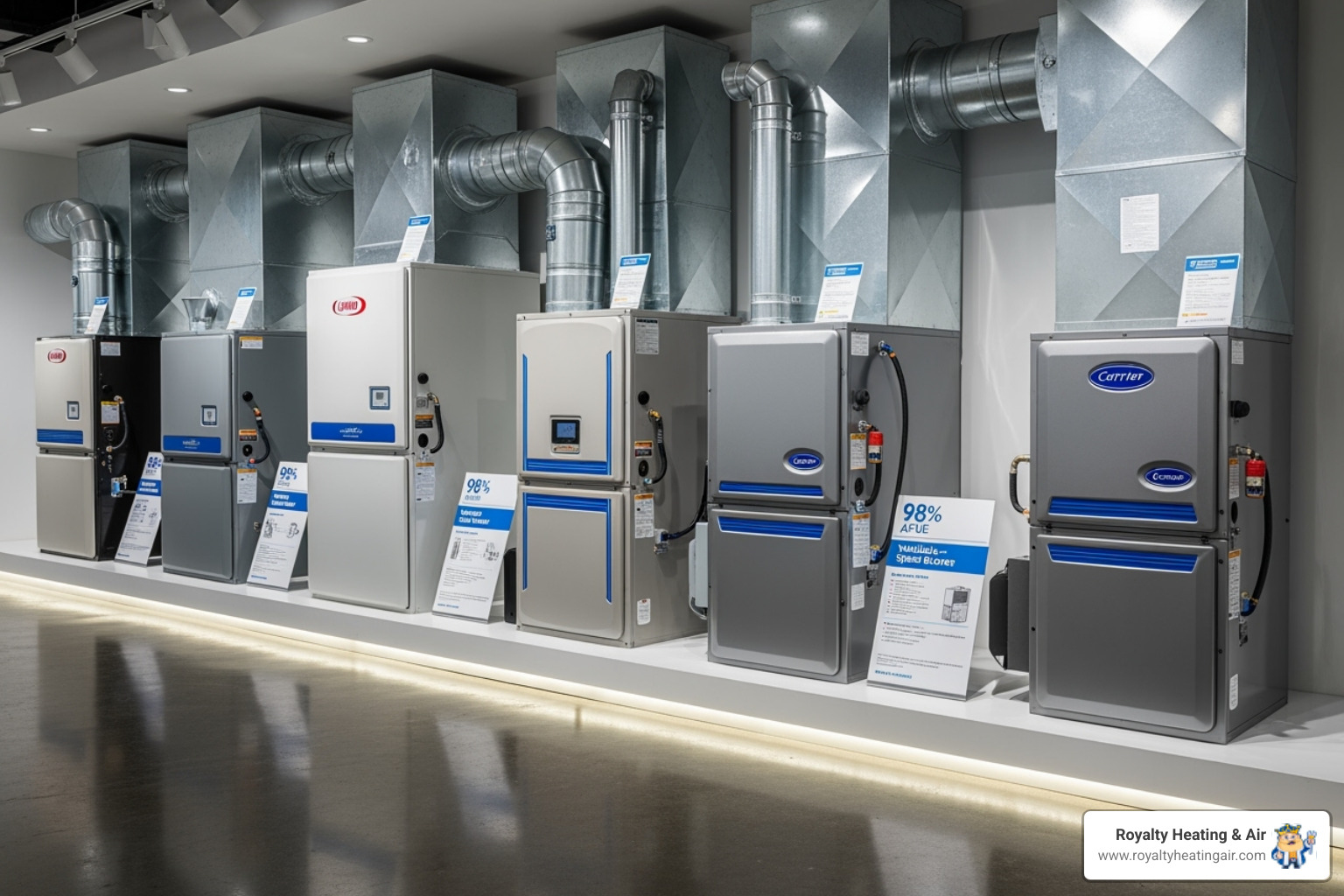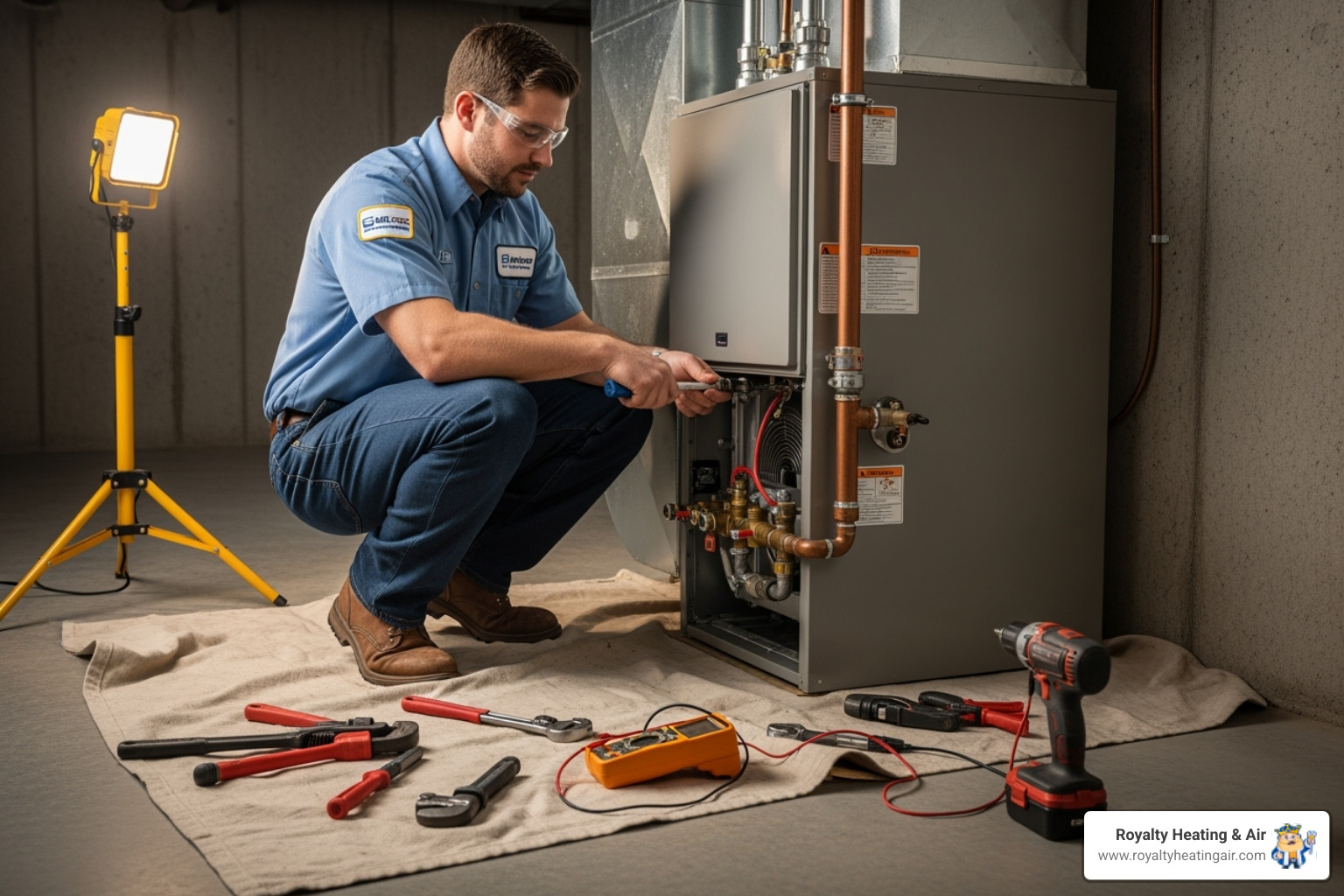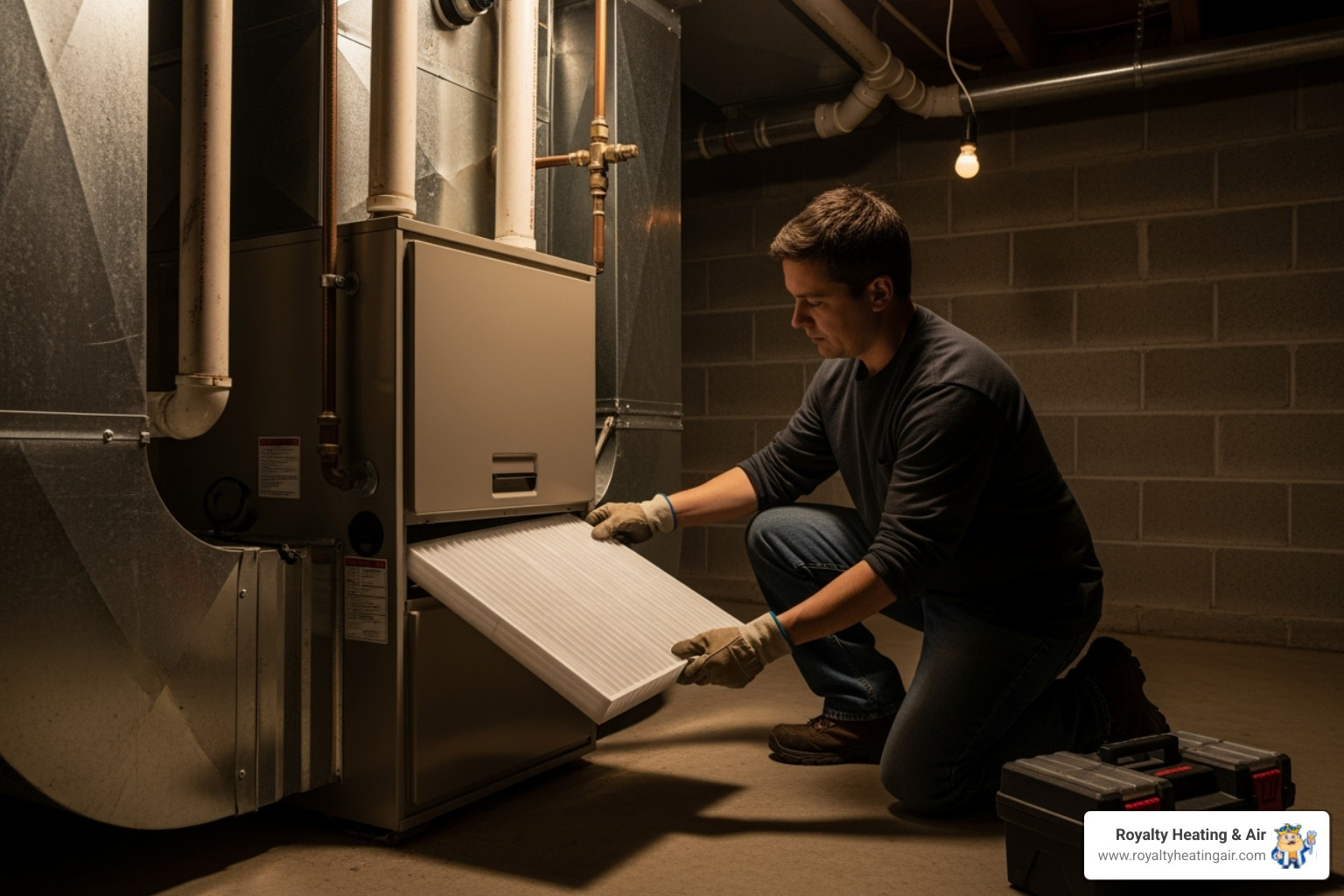Home furnace installation is a critical investment impacting your family's comfort, safety, and energy costs for 15-20 years. Proper installation is not a DIY project; it demands the specialized knowledge, licensing, and safety protocols of certified professionals.
Key components of professional home furnace installation:
Improper installation can cut a furnace's 15-year lifespan in half and increase energy bills by up to 30%. Licensed technicians ensure your system operates at peak efficiency from day one, preventing costly repairs and safety hazards.
As one industry expert notes: "There is nothing worse than getting up cold in the middle of the night." This scenario is more likely when installation isn't handled by qualified professionals who understand proper sizing, safety, and system optimization.
Professional installation also protects your investment. Most manufacturers void warranties without it, leaving you financially responsible for equipment failures or safety issues.

Home furnace installation terms explained:
Your furnace usually provides warning signs before it fails, helping you avoid a cold morning without heat. Most furnaces have a 15-year lifespan, though well-maintained units can last 20 years. If your furnace is approaching this age, pay close attention to its performance.
Rising utility bills are a major red flag. If heating costs climb without changes in your thermostat habits, your furnace is losing efficiency. Modern units operate at 90-98% efficiency, far surpassing older units that may only reach 65%.
Frequent breakdowns are common as furnaces age. If you're constantly calling for Furnace Repair, your system is failing. When repair costs approach 50% of a new unit's price, replacement is the more financially sound option.
Strange noises like screeching, banging, or rattling are not normal. These sounds often indicate worn bearings, loose components, or a cracked heat exchanger.
Uneven heating creates frustrating hot and cold spots. If some rooms are too warm while others are chilly, your furnace likely can't distribute heat effectively anymore.
Soot or dust accumulation around your furnace, vents, or registers can signal serious safety concerns. Excessive dust, dirt, or rust may indicate combustion problems or a deteriorating heat exchanger, which could lead to carbon monoxide issues.
Poor air quality often accompanies a failing furnace. A stuffy home or increased respiratory irritation can mean your furnace isn't filtering air properly or is circulating contaminants.
If these signs sound familiar, don't wait for a breakdown. A professional assessment can determine if you need a repair or a new home furnace installation.
Selecting the right furnace for your home furnace installation is a major decision. Since it will serve your home for 15-20 years, it's crucial to make an informed choice that fits your home, budget, and lifestyle.

Understanding key factors like fuel type, efficiency ratings, proper sizing, and modern features will help you choose a furnace that keeps your family comfortable and your energy bills reasonable.
Your fuel choice typically depends on local availability and your home's existing infrastructure.
Natural gas furnaces are the most common choice where gas lines are available, often providing the most economical heating. Modern natural gas furnaces are highly efficient, with 92-98% AFUE ratings.
Propane furnaces work like natural gas units but offer independence from utility lines, making them ideal for rural homes. While requiring a tank, modern propane furnaces match the high efficiency of natural gas models.
Electric furnaces are simpler to install, needing no venting or fuel lines, and produce zero on-site emissions. They are a good choice for smaller homes or areas with low electricity rates but can be costly to run in colder climates.
Understanding efficiency ratings is key to long-term savings. The most important is the AFUE (Annual Fuel Utilization Efficiency) AFUE rating, which indicates how much of your fuel cost directly heats your home. A 95% AFUE rating means 95 cents of every dollar heats your home.
ENERGY STAR® certified furnaces are about 6% more energy-efficient than standard models, meeting strict government guidelines for efficiency.
The furnace motor type also affects comfort and efficiency.
A common, costly mistake is assuming bigger is better. For furnaces, correct sizing is crucial.
Professional heat loss calculations are essential for proper sizing. A technician measures your home's square footage, insulation, windows, and considers the local climate. This is not a job for online calculators.
Oversized furnaces heat the home too quickly and shut off before circulating air properly. This leads to hot/cold spots, wasted energy, and excess wear on components.
Undersized furnaces run constantly, struggling to maintain temperature and wearing out quickly. In cold weather, they can't keep up.
Getting the sizing right requires a professional assessment. Our team uses industry-standard methods to ensure your new furnace is a perfect match. Learn more in our guide to Home Furnace Installation.
Modern furnaces integrate with smart home systems for intelligent comfort management. Smart thermostats learn your schedule and adjust temperatures automatically.
Wi-Fi connectivity allows you to control your furnace from anywhere with a smartphone. Adjust the heat from the airport or warm the house on your commute home.
Remote temperature control and programmable schedules work together to optimize comfort and efficiency. Many smart thermostats also provide energy usage reports, helping you make small adjustments for significant savings.
For home furnace installation, professionalism is a necessity. Our licensed technicians follow strict safety protocols to ensure a seamless, secure installation.

The process begins with a personalized in-home consultation.
A little preparation helps ensure a smooth installation day.
On installation day, our skilled technicians will install your new heating system.
Before finishing, we ensure your new system operates perfectly and you are comfortable with it.
Your new home furnace installation is an investment in years of comfort. Like a car, it needs regular maintenance to run smoothly, and the required care is straightforward.

Consistent, simple care is the key to a long-lasting furnace and preventing major issues.
Annual professional tune-ups are essential. Our technicians inspect components, perform cleanings, and catch potential problems early. These visits ensure safety and efficiency, leading to lower energy bills and fewer breakdowns.
Regular filter changes are the most important homeowner task. A dirty filter forces your furnace to work harder, wasting energy and risking overheating. Change your filter if you can't see light through it. Most homes require a change every 1-3 months, depending on pets, allergies, and system use.
Keeping vents clear is crucial for proper airflow. Walk through your home occasionally to ensure furniture, rugs, or other items are not blocking supply and return vents.
Our guide on Furnace Maintenance covers common mistakes and how to avoid them.
Understanding your furnace's warranty can save you significant money and provide peace of mind.
Manufacturer's parts warranty typically covers major components for 5-10 years. Registration is key; most manufacturers require it to activate the warranty, which we'll remind you about. This warranty requires professional installation.
Installer's labor warranty covers our workmanship. If an issue arises from the installation, we will correct it.
Extended coverage options and maintenance plans can offer further protection, often including priority service and discounted repairs. Many customers find these plans save money over time by preventing costly emergency repairs.
Regular maintenance is often required to keep your warranties valid. Skipping annual service can void your coverage.
Here are answers to the most common questions we receive about home furnace installation.
This is a common question, and the answer is usually yes. Your heating and cooling systems are partners, sharing ductwork and a blower motor. Pairing a new, efficient furnace with an old AC compromises performance.
Modern HVAC units are engineered as matched systems, where the furnace and air conditioner are designed to complement each other's efficiency and airflow. This partnership maximizes comfort and minimizes energy bills.
From a practical standpoint, replacing both at once is more efficient. It saves time and reduces disruption since our technicians are already on-site. You'll also benefit from year-round energy efficiency improvements and avoid a second major HVAC replacement down the road.
This decision balances ownership against convenience. When you buy your furnace, it becomes a home asset with no monthly fees, and you control all maintenance decisions.
Renting offers predictable monthly payments instead of a large upfront investment. The rental company typically handles all maintenance and repairs, providing a hands-off approach.
However, the long-term value usually favors buying. Rental payments add up significantly over the furnace's 15-20 year lifespan. If you plan to stay in your home, purchasing is typically more economical.
Yes, the savings from a high-efficiency furnace are significant and measurable. The savings come from the AFUE rating impact. An old furnace with a 70% AFUE rating wastes 30 cents of every fuel dollar. A new 95% AFUE unit wastes only 5 cents—a dramatic efficiency improvement.
This reduced fuel consumption directly lowers your monthly bills, with many customers seeing a 20-30% reduction in heating costs. While high-efficiency models have a higher initial cost, the long-term ROI from energy savings often offsets this within a few years.
High-efficiency furnaces also have environmental benefits, as they consume less fossil fuel and reduce your home's carbon footprint.
A home furnace installation is an investment in your family's long-term comfort, safety, and peace of mind. At Royalty Heating & Air, we know the right installation transforms a house into a comfortable home.
Professional installation benefits include long-term savings on energy bills, fewer repairs, and reliable home comfort. Our licensed technicians ensure every connection is secure and every component is calibrated for peak performance, guaranteeing your safety.
We're proud to serve families throughout Northern California. Our service areas include Furnace Installation in Roseville, CA, Furnace Installation in Sacramento, Furnace Installation in Folsom, Furnace Installation in Lincoln, CA, Furnace Installation in Auburn, CA, Furnace Installation in Carmichael, CA, Furnace Installation in Loomis, CA, Furnace Installation in Fair Oaks, CA, Furnace Installation in Orangevale, CA, Furnace Installation in North Highlands, CA, Furnace Installation in Penryn, CA, Furnace Installation in Lodi, Furnace Installation in Plumas Lake, CA, Furnace Installation in Antelope, CA, Furnace Installation in Newcastle, CA, Furnace Installation in Citrus Heights, CA, and Furnace Installation in Granite Bay, CA.
What sets us apart is our commitment to giving back. Through our partnership with the MackAttack Foundation, we support foster babies and sponsor family adoptions. We believe every family deserves a warm, safe home.
Ready to experience the difference professional home furnace installation can make? Contact us for your heating installation in Rocklin, CA or any of our service areas to bring comfort, efficiency, and peace of mind to your home.
